Oscar Sainz
Data Contamination Report from the 2024 CONDA Shared Task
Jul 31, 2024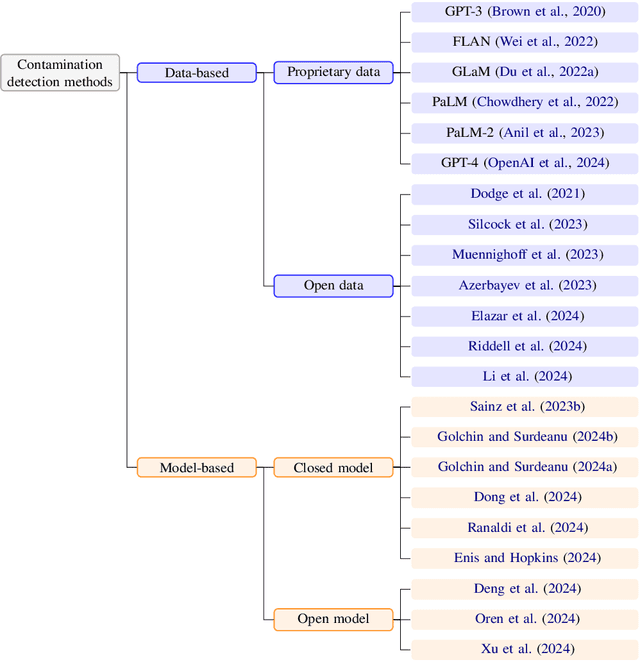
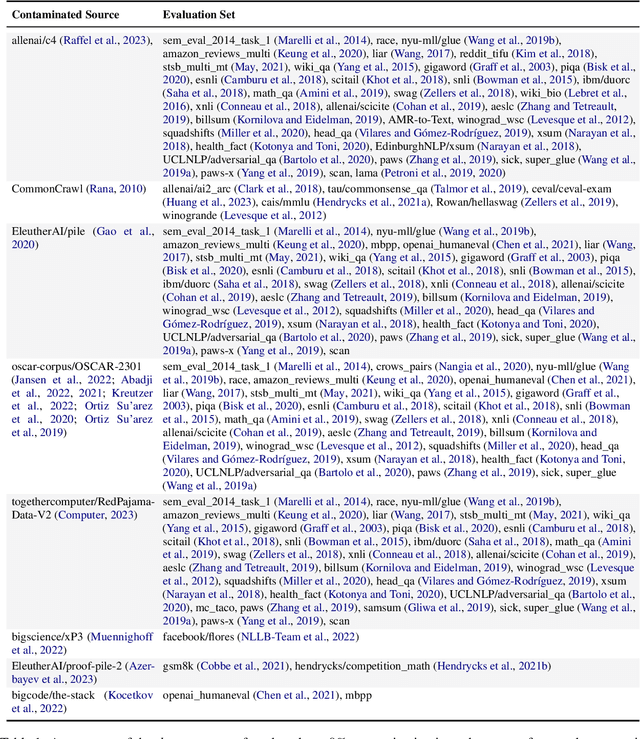
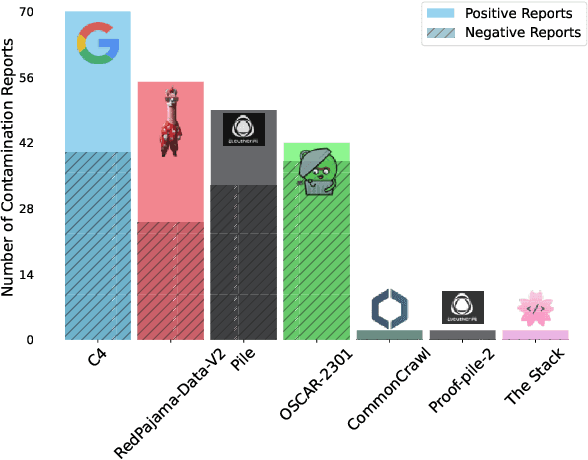
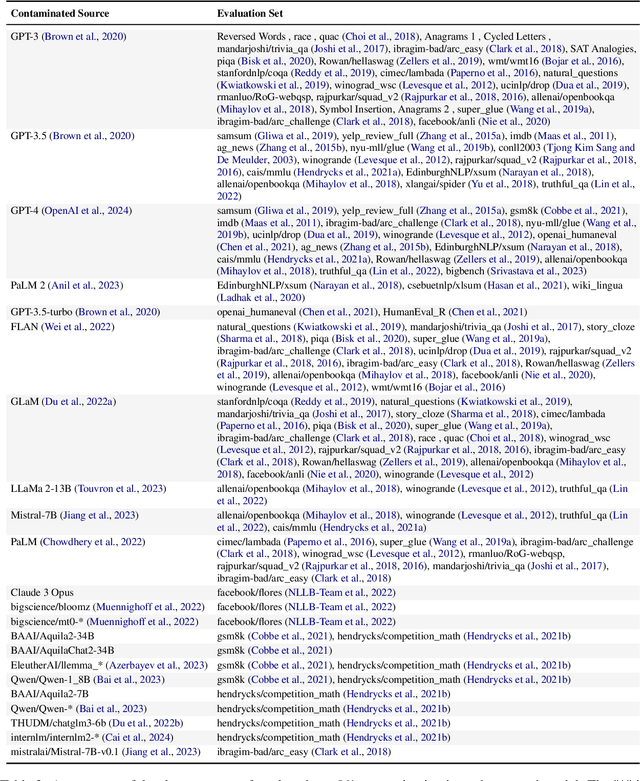
Abstract:The 1st Workshop on Data Contamination (CONDA 2024) focuses on all relevant aspects of data contamination in natural language processing, where data contamination is understood as situations where evaluation data is included in pre-training corpora used to train large scale models, compromising evaluation results. The workshop fostered a shared task to collect evidence on data contamination in current available datasets and models. The goal of the shared task and associated database is to assist the community in understanding the extent of the problem and to assist researchers in avoiding reporting evaluation results on known contaminated resources. The shared task provides a structured, centralized public database for the collection of contamination evidence, open to contributions from the community via GitHub pool requests. This first compilation paper is based on 566 reported entries over 91 contaminated sources from a total of 23 contributors. The details of the individual contamination events are available in the platform. The platform continues to be online, open to contributions from the community.
Event Extraction in Basque: Typologically motivated Cross-Lingual Transfer-Learning Analysis
Apr 09, 2024Abstract:Cross-lingual transfer-learning is widely used in Event Extraction for low-resource languages and involves a Multilingual Language Model that is trained in a source language and applied to the target language. This paper studies whether the typological similarity between source and target languages impacts the performance of cross-lingual transfer, an under-explored topic. We first focus on Basque as the target language, which is an ideal target language because it is typologically different from surrounding languages. Our experiments on three Event Extraction tasks show that the shared linguistic characteristic between source and target languages does have an impact on transfer quality. Further analysis of 72 language pairs reveals that for tasks that involve token classification such as entity and event trigger identification, common writing script and morphological features produce higher quality cross-lingual transfer. In contrast, for tasks involving structural prediction like argument extraction, common word order is the most relevant feature. In addition, we show that when increasing the training size, not all the languages scale in the same way in the cross-lingual setting. To perform the experiments we introduce EusIE, an event extraction dataset for Basque, which follows the Multilingual Event Extraction dataset (MEE). The dataset and code are publicly available.
Latxa: An Open Language Model and Evaluation Suite for Basque
Mar 29, 2024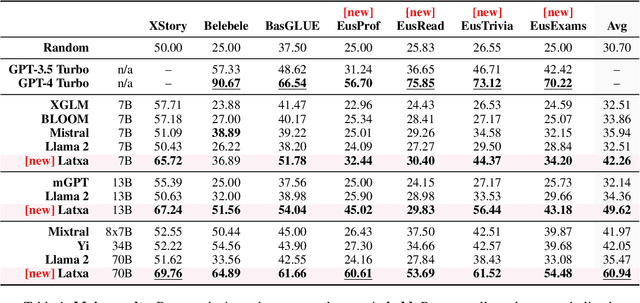
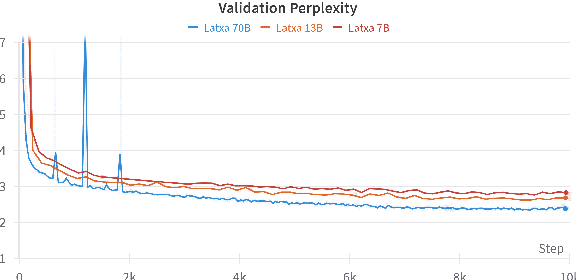

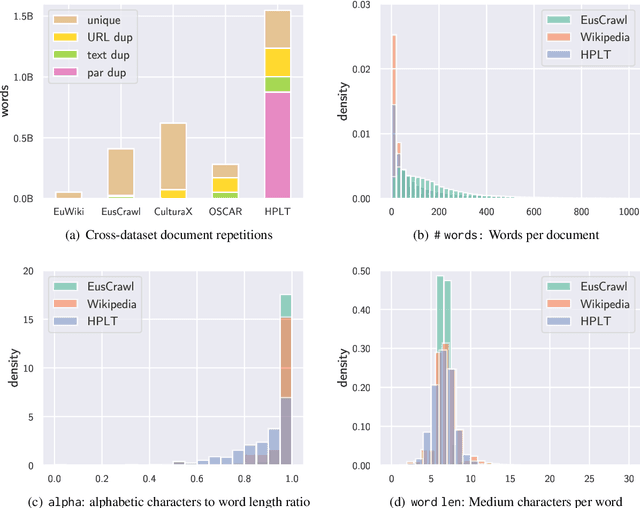
Abstract:We introduce Latxa, a family of large language models for Basque ranging from 7 to 70 billion parameters. Latxa is based on Llama 2, which we continue pretraining on a new Basque corpus comprising 4.3M documents and 4.2B tokens. Addressing the scarcity of high-quality benchmarks for Basque, we further introduce 4 multiple choice evaluation datasets: EusProficiency, comprising 5,169 questions from official language proficiency exams; EusReading, comprising 352 reading comprehension questions; EusTrivia, comprising 1,715 trivia questions from 5 knowledge areas; and EusExams, comprising 16,774 questions from public examinations. In our extensive evaluation, Latxa outperforms all previous open models we compare to by a large margin. In addition, it is competitive with GPT-4 Turbo in language proficiency and understanding, despite lagging behind in reading comprehension and knowledge-intensive tasks. Both the Latxa family of models, as well as our new pretraining corpora and evaluation datasets, are publicly available under open licenses at https://github.com/hitz-zentroa/latxa. Our suite enables reproducible research on methods to build LLMs for low-resource languages.
NLP Evaluation in trouble: On the Need to Measure LLM Data Contamination for each Benchmark
Oct 27, 2023Abstract:In this position paper, we argue that the classical evaluation on Natural Language Processing (NLP) tasks using annotated benchmarks is in trouble. The worst kind of data contamination happens when a Large Language Model (LLM) is trained on the test split of a benchmark, and then evaluated in the same benchmark. The extent of the problem is unknown, as it is not straightforward to measure. Contamination causes an overestimation of the performance of a contaminated model in a target benchmark and associated task with respect to their non-contaminated counterparts. The consequences can be very harmful, with wrong scientific conclusions being published while other correct ones are discarded. This position paper defines different levels of data contamination and argues for a community effort, including the development of automatic and semi-automatic measures to detect when data from a benchmark was exposed to a model, and suggestions for flagging papers with conclusions that are compromised by data contamination.
GoLLIE: Annotation Guidelines improve Zero-Shot Information-Extraction
Oct 06, 2023Abstract:Large Language Models (LLMs) combined with instruction tuning have made significant progress when generalizing to unseen tasks. However, they have been less successful in Information Extraction (IE), lagging behind task-specific models. Typically, IE tasks are characterized by complex annotation guidelines which describe the task and give examples to humans. Previous attempts to leverage such information have failed, even with the largest models, as they are not able to follow the guidelines out-of-the-box. In this paper we propose GoLLIE (Guideline-following Large Language Model for IE), a model able to improve zero-shot results on unseen IE tasks by virtue of being fine-tuned to comply with annotation guidelines. Comprehensive evaluation empirically demonstrates that GoLLIE is able to generalize to and follow unseen guidelines, outperforming previous attempts at zero-shot information extraction. The ablation study shows that detailed guidelines is key for good results.
IXA/Cogcomp at SemEval-2023 Task 2: Context-enriched Multilingual Named Entity Recognition using Knowledge Bases
Apr 27, 2023Abstract:Named Entity Recognition (NER) is a core natural language processing task in which pre-trained language models have shown remarkable performance. However, standard benchmarks like CoNLL 2003 do not address many of the challenges that deployed NER systems face, such as having to classify emerging or complex entities in a fine-grained way. In this paper we present a novel NER cascade approach comprising three steps: first, identifying candidate entities in the input sentence; second, linking the each candidate to an existing knowledge base; third, predicting the fine-grained category for each entity candidate. We empirically demonstrate the significance of external knowledge bases in accurately classifying fine-grained and emerging entities. Our system exhibits robust performance in the MultiCoNER2 shared task, even in the low-resource language setting where we leverage knowledge bases of high-resource languages.
What do Language Models know about word senses? Zero-Shot WSD with Language Models and Domain Inventories
Feb 07, 2023



Abstract:Language Models are the core for almost any Natural Language Processing system nowadays. One of their particularities is their contextualized representations, a game changer feature when a disambiguation between word senses is necessary. In this paper we aim to explore to what extent language models are capable of discerning among senses at inference time. We performed this analysis by prompting commonly used Languages Models such as BERT or RoBERTa to perform the task of Word Sense Disambiguation (WSD). We leverage the relation between word senses and domains, and cast WSD as a textual entailment problem, where the different hypothesis refer to the domains of the word senses. Our results show that this approach is indeed effective, close to supervised systems.
Textual Entailment for Event Argument Extraction: Zero- and Few-Shot with Multi-Source Learning
May 03, 2022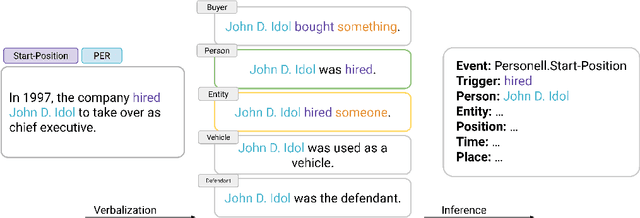
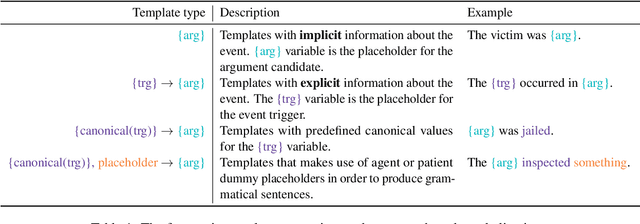
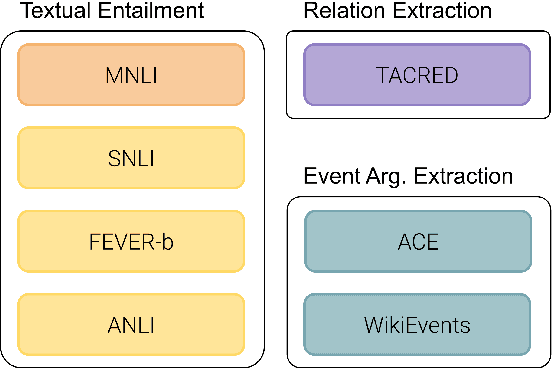
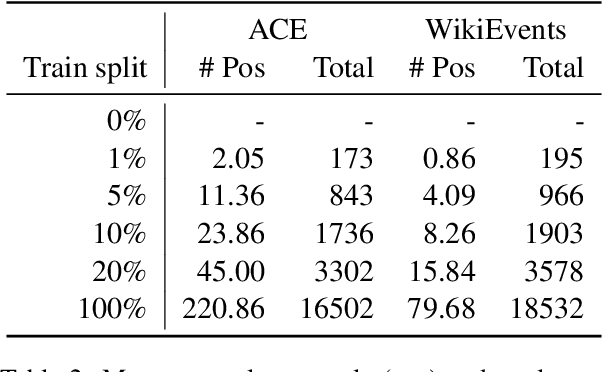
Abstract:Recent work has shown that NLP tasks such as Relation Extraction (RE) can be recasted as Textual Entailment tasks using verbalizations, with strong performance in zero-shot and few-shot settings thanks to pre-trained entailment models. The fact that relations in current RE datasets are easily verbalized casts doubts on whether entailment would be effective in more complex tasks. In this work we show that entailment is also effective in Event Argument Extraction (EAE), reducing the need of manual annotation to 50% and 20% in ACE and WikiEvents respectively, while achieving the same performance as with full training. More importantly, we show that recasting EAE as entailment alleviates the dependency on schemas, which has been a road-block for transferring annotations between domains. Thanks to the entailment, the multi-source transfer between ACE and WikiEvents further reduces annotation down to 10% and 5% (respectively) of the full training without transfer. Our analysis shows that the key to good results is the use of several entailment datasets to pre-train the entailment model. Similar to previous approaches, our method requires a small amount of effort for manual verbalization: only less than 15 minutes per event argument type is needed, and comparable results can be achieved with users with different level of expertise.
ZS4IE: A toolkit for Zero-Shot Information Extraction with simple Verbalizations
Mar 28, 2022


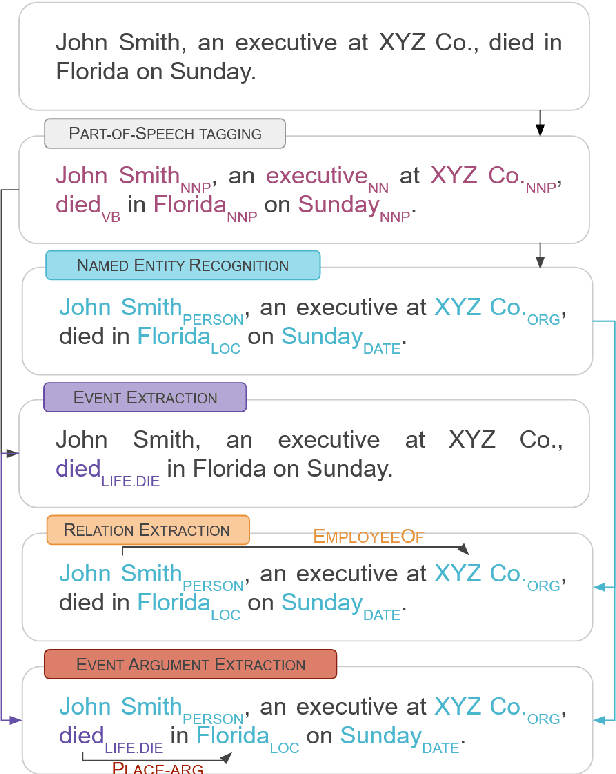
Abstract:The current workflow for Information Extraction (IE) analysts involves the definition of the entities/relations of interest and a training corpus with annotated examples. In this demonstration we introduce a new workflow where the analyst directly verbalizes the entities/relations, which are then used by a Textual Entailment model to perform zero-shot IE. We present the design and implementation of a toolkit with a user interface, as well as experiments on four IE tasks that show that the system achieves very good performance at zero-shot learning using only 5--15 minutes per type of a user's effort. Our demonstration system is open-sourced at https://github.com/BBN-E/ZS4IE . A demonstration video is available at https://vimeo.com/676138340 .
Recent Advances in Natural Language Processing via Large Pre-Trained Language Models: A Survey
Nov 01, 2021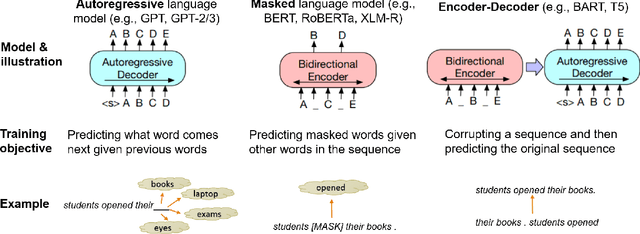
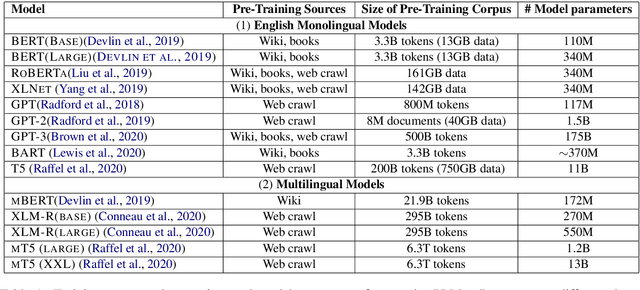
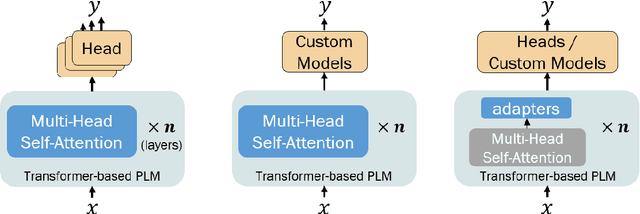
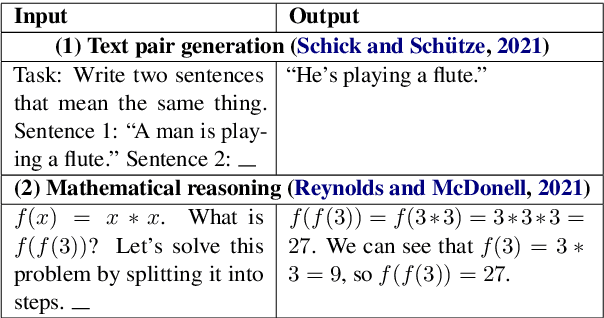
Abstract:Large, pre-trained transformer-based language models such as BERT have drastically changed the Natural Language Processing (NLP) field. We present a survey of recent work that uses these large language models to solve NLP tasks via pre-training then fine-tuning, prompting, or text generation approaches. We also present approaches that use pre-trained language models to generate data for training augmentation or other purposes. We conclude with discussions on limitations and suggested directions for future research.
 Add to Chrome
Add to Chrome Add to Firefox
Add to Firefox Add to Edge
Add to Edge